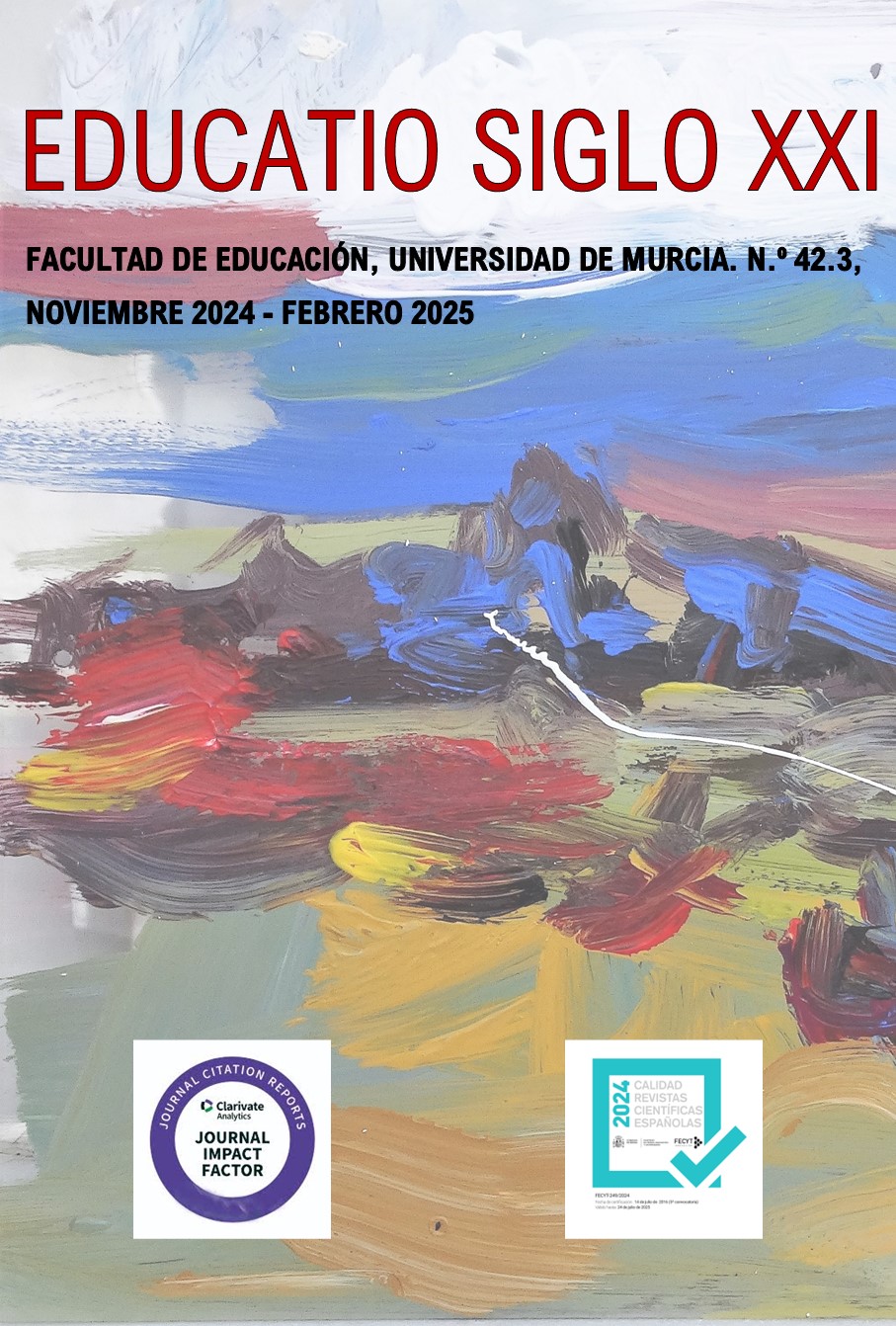Factores familiares sociodemográficos y perpetración de ciberacoso en Educación Primaria en España
Resumen
El ciberacoso es un acto agresivo e intencional de un agresor/es hacia una víctima, mediante el uso de las tecnologías. La prevalencia de la perpetración de ciberacoso en Educación Primaria en España se sitúa entre el 1.3% y el 13.3%, aunque se ha incrementado a causa del confinamiento derivado de la COVID-19. La cibervictimización en Educación Secundaria y las variables familiares dinámicas han sido más estudiadas en comparación con la ciberperpetración en Educación Primaria y las variables familiares sociodemográficas, respectivamente. Por ello, el objetivo del estudio consiste en evaluar la relación entre las variables sociodemográficas familiares (edad, género, nivel educativo, antecedentes de inmigración, estructura familiar y grado de ruralidad del municipio de residencia familiar) y la ciberperpetración de sus hijos en Educación Primaria. Una muestra constituida por 1169 familias del alumnado de 5º y 6º de Educación Primaria, fue encuestada mediante un cuestionario autoadministrado (α = .84). El análisis de datos se realizó a través de la regresión logística binaria utilizando el software estadístico R versión 4.1.0. El modelo multivariante se implementó a partir de un procedimiento stepwise hasta obtener el mejor modelo predictivo en términos del Criterio de Información de Akaike (AIC). Los antecedentes de inmigración, el nivel educativo del progenitor y la estructura familiar influyen significativamente de forma conjunta en la ciberperpetración de los estudiantes de Educación Primaria. Se concluye que las variables familiares sociodemográficas predicen la implicación del alumnado como ciberagresor. Se propone el desarrollo de un programa de prevención del ciberacoso siguiendo los modelos de whole policy.
Descargas
-
Resumen639
-
PDF403
Citas
Abdulsalam, A., Aldaihani, A., & Francis, K. (2017). Prevalence and Associated Factors of Peer Victimization (Bullying) among Grades 7 and 8 Middle School Students in Kuwait. International Journal of Pediatrics, 2017(3), 1-8. http://doi.org/10.1155/2019/8462304
Adigwe, I. (2021). Identifying the Moderating and Mediating Variables in Parental Mediation Practices in Nigerian Families in the Digital Age. Social Media+Society, 7(3), 1-12. http://doi.org/10.1177/20563051211033817
Alonso-Montejo, M.M., Zamorano-González, E., & Ledesma-Albarránc, J.M. (2019). ¿Qué saben nuestros niños de la escuela primaria sobre acoso escolar? Revista Pediatría Atención Primaria, 21(82), 121-129. https://bit.ly/3TqnONT
Anccana, L. P., Copaja, F. H., & Mandarachi, R. P. (2022). Ciberbullyng en tiempos de pandemia. Ciencia Latina Revista Científica Multidisciplinar, 6(4), 1274-1286. http://doi.org/10.37811/cl_rcm.v6i4.2660
Arató, N., Zsidó, A. N., Lénárd, K., & Lábadi, B. (2020). Cybervictimization and cyberbullying: The role of socio-emotional skills. Frontiers in psychiatry, 11, 248. http://doi.org/10.3389/fpsyt.2020.00248
Bevilacqua, L., Shackleton, N., Hale, D., Allen, E., Bond, L., Christie, D., Elbourne, D., Fitzgerald-Yau, N., Fletcher, A., Jones, R., Miners, A., Scott, S., Wiggins, M., Bonell, C., & Viner, R. (2017). The role of family and school-level factors in bullying and cyberbullying: A cross-sectional study. BMC Pediatrics, 17(160), 160-170. http://doi.org/10.1186/s12887-017-0907-8
Beyazit, U., Şimşek, S., & Ayhan, A.B. (2017). An examination of the predictive factors of cyberbullying in adolescents. Social Behavior and Personality: an international journal, 45(9), 1511-1522. http://doi.org/10.2224/sbp.6267
Çakır, Ö., Gezgin, D. M., & Ayas, T. (2016). The Analysis of the Relationship between Being a Cyberbully and Cybervictim among Adolescents in Terms of Different Variables. International Journal of Progressive Education, 12(3), 134-154. https://bit.ly/3zXJ9Da
Calmaestra, J., Rodríguez-Hidalgo, A.J., Mero-Delgado, O., & Solera, E. (2020). Cyberbullying in Adolescents from Ecuador and Spain: Prevalence and Differences in Gender, School Year and Ethnic-Cultural Background. Sustainability, 12, 4597. http://doi.org/10.3390/su12114597
Camerini, A-L., Marciano, L., Carrara, A., & Schulz, P. (2020). Cyberbullying perpetration and victimization among children and adolescents: A systematic review of longitudinal studies. Telematics and Informatics, 49, 1-13. http://doi.org/10.1016/j.tele.2020.101362.
Comas-Forgas, R., Sureda-Negre, J., & Calvo-Sastre, A. (2017). Characteristics of Cyberbullying Among Native and Immigrant Secondary Education Students. International Journal of Cyber Behavior, Psychology and Learning, 7, 1-17. http://doi.org/10.4018/IJCBPL.2017010101
Cox, D.R. (1970). Analysis of Binary Data. Chapman and Hall.
Dedkova, L., & Smahel, D. (2019). Online Parental Mediation: Associations of Family Members´ Characteristics to Individual Engagement in Active Mediation and Monitoring. Journal of Family Issues, 41(8), 1-25. http://doi.org/10.1177/0192513X19888255
Dujmic, Z., Cosic, V., Rajkovaca, I., Vcev, A. & Miskic, B. (2019). Cyberbullying in Early Adolescence: Is There a Difference Between Urban and Rural Environment? Am J Biomed Sci & Res., 1(5), 191-196. http://doi.org/10.34297/AJBSR.2019.01.000542
Estévez, M. (2021). Acoso escolar y ciberacoso en educación primaria: prevalencia e intervención psicoeducativa (Tesis doctoral, Universidad de Sevilla). https://bit.ly/3VeXwgF
Garaigordobil, M. (2011). Prevalencia y consecuencias del cyberbullying: Una revisión. International Journal of Psychology and Psychological Therapy, 11(2), 233-254. https://bit.ly/2JqSAV5
Hosmer, D., Lemeshow, S., & Sturdivant, R.X. (2000). Applied Logistic Regression. John Wiley & Sons.
Li, B., & Babu, G.J. (2019). A graduate course on statistical inference. Springer.
Livingstone, S., Mascheroni, G., Dreier, M., Chaudron, S., & Lagae, K. (2015). How parents of young children manage digital devices at home: The role of income, education and parental style. EU Kids Online, LSE. https://bit.ly/3VdxR8a
Livingstone, S., Ólafsson, K., Helsper, E. J., Lupiáñez-Villanueva, F.,
Veltri, G. A., & Folkvord, F. (2017). Maximizing Opportunities and
Minimizing Risks for Children Online: The Role of Digital Skills in
Emerging Strategies of Parental Mediation. Journal of Communication,
(1), 82-105. http://doi.org/10.1111/jcom.12277
López-Castro, L., Priegue, D. (2019). Influence of Family Variables on Cyberbullying Perpetration and Victimization: A Systematic Literature Review. Social Science, 8(3), 98-123. http://doi.org/10.3390/socsci8030098
Machimbarrena, J.M., & Garaigordobil, M. (2018). Prevalence of bullying and
cyberbullying in the last stage of primary education in the Basque Country. The Spanish Journal of Psychology, 21(e48), 1-10. http://doi.org/10.1017/sjp.2018.41
Machimbarrena, J. M., González-Cabrera, J., & Garaigordobil, M. (2019). Variables familiares relacionadas con el bullying y el cyberbullying: Una revisión sistemática. Pensamiento Psicológico, 17(2), 37-56. http://doi.org/10.11e144/javerianacali.ppsi17-2.vfrb
Nikken, P., & Schols, M. (2015). How and Why Parents Guide the Media Use of Young Children. Journal of Child and Family Study, 24(11), 3423-3435. http://doi.org/10.1007/s10826-015-0144-4
Peter, I.K., & Petermann, F. (2018). Cyberbullying: A concept analysis of defining attribures and additional influencing factors. Rev. Computers in human behavior, 86, 350-366. http://doi.org/10.1016/j.chb.2018.05.013
R Core Team. (2020). R: A language and environment for statistical computing. R Foundation for Statistical Computing. https://CRAN.R-project.org/
Ripley, B. (2020). MASS: Support Functions and Datasets for Venables and Ripley’s Mass. https://CRAN.R-project.org/package=MASS.
Rodríguez-Álvarez, J. M., Navarro, R., & Yubero, S. (2022). Bullying/cyberbullying en quinto y sexto curso de educación primaria: diferencias entre contextos rurales y urbanos. Psicología Educativa, 28(2), 117-126. http://doi.org/10.5093/psed2021a18
Sidera, F., Serrat, E., Collell, J., Perpiñà, G., Agell, S., Ortiz, R., Amadó, A., & Rostan, C. (2021). Informe sobre el acoso y el ciberacoso en la educación primaria en Cataluña. Fundación Barça. https://bit.ly/3v2tJgE
Smith, P.K. (2019). Research on Cyberbullying: strengths and Limitations. In H. Vandebosch and L. Green (Eds.), Narratives in research and interventions on cyberbullying among young people (pp. 9-27). Springer Cham. http://doi.org/10.1007/978-3-030-04960-7_2
Smith, P.K., Mahdavi, J., Carvalho, M., Fisher, S., Russell, S., & Tippett, N. (2008). Cyberbullying: Its nature and impact in secondary school pupils. Journal of child psychology and psychiatry, 49(4), 376-385. http://doi.org/10.1111/j.1469-7610.2007.01846.x
Talleyrand, R., & Vojtech, J. (2019). Potential stressors of undocumented Latinx youth: Implications and recommendations for school counselors. Professional School Counseling, 22(1), 1-8. http://doi.org/10.1177/2156759X19847168
Uludasdemir, D., & Kucuk, S. (2019). Cyber Bullying Experiences of Adolescents and Parental Awareness: Turkish Example. Journal of pediatric nursing, 44, 84-90. http://doi.org/10.1016/j.pedn.2018.11.006
Wright, M. F. (2017). Parental mediation, cyberbullying, and cybertrolling: The role of gender. Computers in Human Behavior, 71, 189–195. http://doi.org/10.1016/j.chb.2017.01.059
Derechos de autor 2024 Servicio de Publicaciones de la Universidad de Murcia

Esta obra está bajo una licencia internacional Creative Commons Atribución-NoComercial-SinDerivadas 4.0.
Las obras que se publican en esta revista están sujetas a los siguientes términos:
1. El Servicio de Publicaciones de la Universidad de Murcia (la editorial) conserva los derechos patrimoniales (copyright) de las obras publicadas, y favorece y permite la reutilización de las mismas bajo la licencia de uso indicada en el punto 2.
2. Las obras se publican en la edición electrónica de la revista bajo una licencia Creative Commons Reconocimiento-NoComercial-SinObraDerivada 4.0 Internacional (texto legal). Se pueden copiar, usar, difundir, transmitir y exponer públicamente, siempre que: i) se cite la autoría y la fuente original de su publicación (revista, editorial y URL de la obra); ii) no se usen para fines comerciales; iii) se mencione la existencia y especificaciones de esta licencia de uso.
3. Condiciones de auto-archivo. Se permite y se anima a los autores a difundir electrónicamente las versiones pre-print (versión antes de ser evaluada) y/o post-print (versión evaluada y aceptada para su publicación) de sus obras antes de su publicación, ya que favorece su circulación y difusión más temprana y con ello un posible aumento en su citación y alcance entre la comunidad académica. Color RoMEO: verde.











